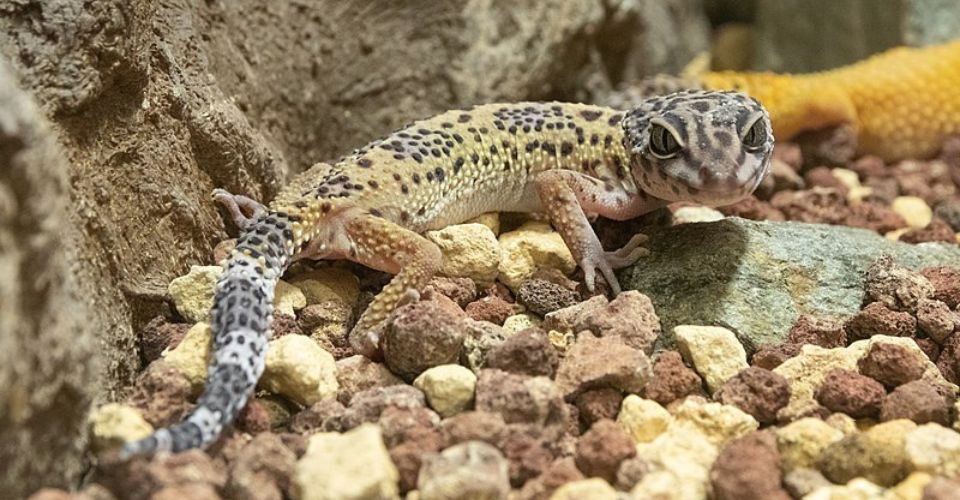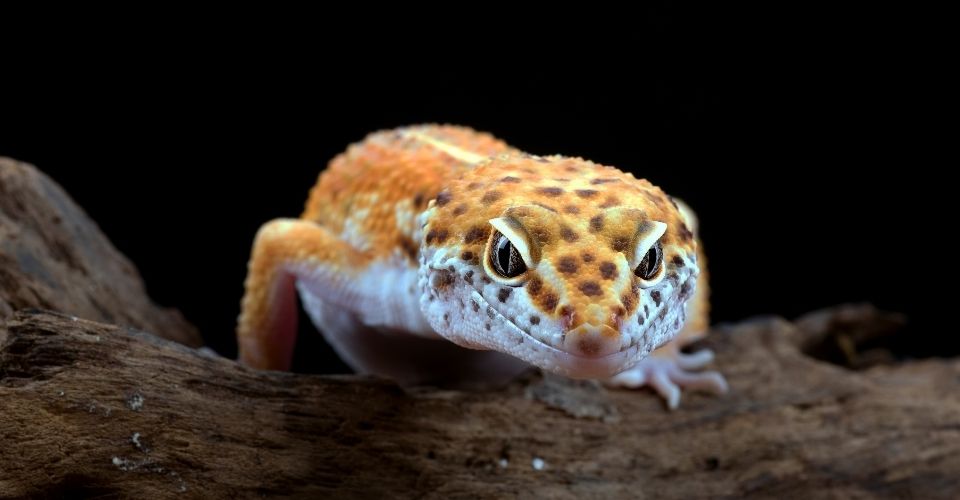Affectionately called Leos, Leopard geckos are generally easy-to-care-for reptiles. When housed properly with the right substrate, temperature gradient, and humidity levels, Leopard geckos generally have a healthy lifespan of about 20 years without experiencing any serious health issues during their lifetime. But for that, you have to learn how to properly house a Leopard gecko.
Housing Leopard Gecko
Leopard geckos are hardy creatures and won’t complain if something in their environment is not perfect. That said, your Leopard gecko will be the happiest and healthiest if you house them in a tank that mimics its natural habitat.
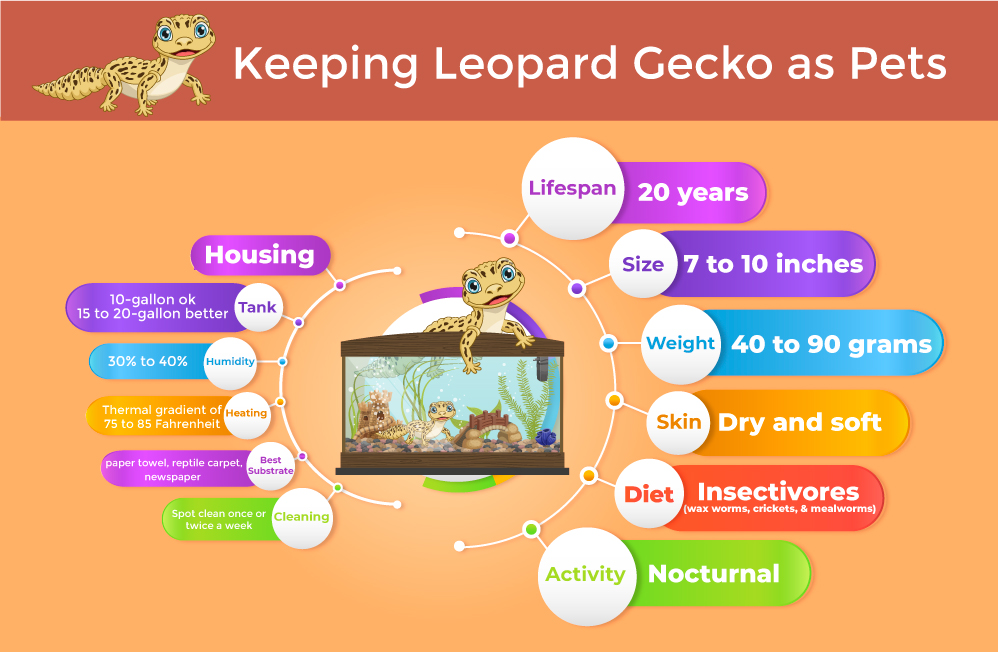
Natural Leopard Gecko Habitat
Naturally, Leopard geckos are found in the deserts and arid grasslands of Pakistan, Afghanistan, northwest India, and Iran. The natural Leopard gecko habitat consists of rocky and sandy (mix of gravel or clay) terrain. Leos move into rock crevices and burrows to maintain their body temperature. Similarly, when the sand is too hot, they tend to rest in shady areas during the day. To create the best Leopard gecko tank setup, you should try to mimic the attributes of their natural habitat as much as possible.
Leopard Gecko Tank Requirements
Tank Size
For single: 10-gallon is ok, but 15 to 20-gallon tank is better
Pair or Trio: 29 to 30-gallon tank
Humidity: 30% to 40%
Lighting: 40 to 60-watt bulb for 29-gallon tank with a room temperature of 70° Fahrenheit
Heating: Thermal gradient with the cooler side at 75 and basking zone at around 85 Fahrenheit
Best Substrate: paper towel, reptile carpet, newspaper
Cleaning: Spot clean once or twice a week
Here’s all you need to know about housing your Leopard gecko.
Leopard Gecko Tank Size: What Size Tank for Leopard Gecko?
A 10-gallon aquarium would be just fine for a single adult Leopard gecko, but your little bud would really appreciate it if you put it in a 15 to 20-gallon tank. If you have a smaller tank, you can still make the enclosure larger (from the gecko’s perspective) by increasing the vertical space. This can be done by using driftwood and rocks to create shelves and ledges.
Similarly, if you have a pair or trio of Leopard geckos, you should get at least a 29 or 30-gallon tank. You should also make sure that there is only one male Leopard gecko per habitat. That said, housing two female geckos or one male and two female geckos would be no trouble.
Leopard Gecko Tank Thrifty Tip!
An old fish tank that has been rendered useless as it could not hold water anymore can work perfectly to house your Leopard geckos.
Leopard Gecko Tank Setup
You cannot simply put your Leopard gecko in an empty tank; you will need a few things in addition to the tank as well to make the tank a natural habitat for your Leopard gecko.
Below we have listed some of the basic things you will need for the Leopard gecko tank setup.
Leopard Gecko Tank Setup Essentials
-
Substrate
Basking light
Hide box
Screen Lid
Water dish
Worm Dish
Thermometer-cum-Hygrometer
Leopard Gecko Substrate
Leopard geckos should not be kept on the glass floor of the aquarium—it would make it pretty hard to clean without having to transfer your Leopard gecko to another habitat. Therefore, essential flooring called substrate is used to comfort your gecko and make the gecko tank setup more comfortable and appealing.
Many substrates can be used for the flooring of your Leopard gecko’s tank. But some substrates are more suitable than others.
| Substrate for Leopard Gecko Tank Setup | |
|---|---|
| Good to Go With | Try to Avoid |
| Paper towel | Sand (including calcium sand) |
| Reptile carpet | Wood shavings |
| Newspaper | Sharp-edged gravel |
Best Substrate Options for Leopard Gecko Tank Setup
Paper towel is the best substrate for your Leopard gecko tank and is a go-to option for commercial gecko breeders. Paper towels not only provide secure footing but also are good absorbent and can easily be discarded and replaced when soiled.
To give your Leopard gecko tank a bit more natural look but still easy to clean, you can use reptile carpets. A cheaper and safe Leopard gecko substrate would be a newspaper—they are fairly absorbent and can be easily discarded and replaced.
Before You Use Sand Substrate
Sand has been one of the most popular substrate choices, but today many experts advise against using sand, even calcium sand, as a substrate. They argue that geckos may ingest sand with their food, which can block their digestive tracts.
On the other hand, some experts argue that where some reptiles and amphibian species experience problems with sand as substrate, Leopard geckos do quite well when kept on sand; after all, they are desert-dwelling geckos.
However, as our mantra, “it’s better to err on the side of caution,” we advise against using the sand substrate. If you are going to use sand as a substrate, you should check it with your vet first.
If you are going ahead with sand, you may also want to throw in some aquarium gravel stones and orchid bark, and sphagnum moss to give it a more natural look.
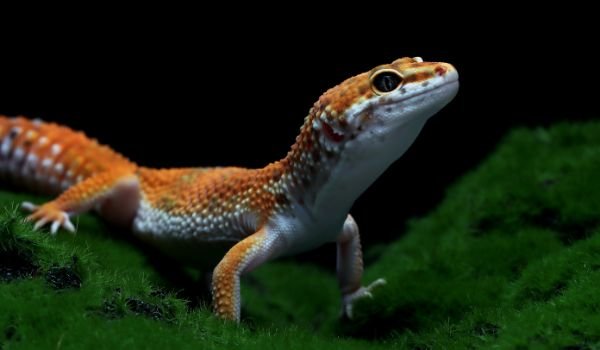
Substrates to Avoid
You should avoid all those substrates that have a threat to injure your Leopard gecko’s tiny feet. For instance, sharp-edged gravels and wood shavings should never be put in a gecko’s habitat as they may cause a skin injury. Wood shavings may also have essential oils that your Leopard gecko may find irritating.
Leopard Gecko Substrate Safety Tip!
Whatever substrate you choose to use, make sure it neither injures your gecko’s tiny feet nor gets ingested with food.
Leopard Gecko Temperature Requirements
Leopard geckos are cold-blooded creatures and thus need an appropriate thermal gradient to maintain their body temperature. The ideal thermal gradient for Leopard geckos would be 88°F to 75°F during the day and 75°F to 70°F during the nighttime. While you should never use hot rocks to provide warmth to your Leopard gecko, under-tank heating pads are also discouraged as they can cause burns.
Leopard Geckos Need Some Light
Unlike most lizards, which are active during the day and must be provided with ultraviolet A and ultraviolet B light in captivity, Leopard geckos are nocturnal and get their vitamin D from their diet and thus don’t necessarily require ultraviolet lights. However, light is essential to stimulate the day and night cycle. In the wild, Leopard geckos are also active during the dawn and dusk and thus get some exposure to scant sunlight during those hours.
Basking Light for Leopard Geckos
The overhead basking light would not only warm the floor substrate but also the air. Keep in mind that your Leopard gecko might not directly bask in the light, but they might use the residual heat even after the light has been turned off.
In a good Leopard gecko lighting setup, the basking light will be placed on one side of the cage. This side of the cage will be warmer, and the other will be cooler. This will allow your cold-blooded Leopard gecko to maintain their body temperature by moving to the warmer and cooler side accordingly.
As Leopard geckos don’t require full-spectrum lighting, you don’t have to get an expensive reptile bulb—an incandescent bulb would work just fine as basking light.
As far as the wattage is concerned, it is dependent on the temperature of the room and the size of the gallon. If you have a 29-gallon tank and the room temperature is 70 Fahrenheit (21 Celsius), a 40 to 60-watt bulb would work perfectly. It would warm the side of the tank where the bulb is placed to about 85 Fahrenheit (29 Celsius) and the other side to about 75 Fahrenheit (24 Celsius), just the thermal gradient that Leopard geckos love.
At night, you should turn off the light. It is fine for tank temperature to drop between 68 to 72 Fahrenheit (20 to 22 Celsius). But if you think your room gets way colder at night, you should place an under-tank heat pad to maintain a minimum temperature.
To keep track of the temperature of the Leopard gecko tank, you can place two thermometers in the tank, one on the side where there is light and the other on the cooler side.
Heating Pad for Leopard Geckos
Instead of basking light, you can also use under-tank heating pads to keep the floor warm. Where the light would be warming the floor and air, the heating pad would only warm the floor. More so, if your gecko was to burrow down to the glass surface of the vivarium, the heating pad may burn it. Therefore, it is best to use basking light instead of heating pads.
Leopard Gecko Overhead Lighting Tips
- You can use the household incandescent bulb instead of buying an expensive reptile bulb.
- Place the basking light on one side—it would help create a thermal gradient that geckos require
- Never leave basking night on throughout the night. Geckos are nocturnal and thus require dark during nighttime.
- You can adjust overhead light timing to adjust your Leopard gecko’s activity periods.
- Don’t place the Leopard gecko tank beside a window, where sunlight may shine directly on the tank—it could overheat and kill a gecko.
- If you have placed some plants in the vivarium, you may have to get a full-spectrum fluorescent light to provide ample light for the plants.
- In winters, you should give your gecko around 12 hours of light, and in summer, as days are long, you should increase light time to 14 hours.
Leopard Gecko Humidity
Leopard geckos come from dry areas—desert to arid grasslands—so one would assume that they don’t need high levels of humidity, but it is not the case. No doubt, Leopard geckos are desert-dwelling reptiles; they spend most of their day in burrows below ground where there is a high level of moisture.
Where the ideal humidity for the Leopard gecko tank is 30% to 40%, that of the humid hides should be around 70% to 80%. Humidity below 20% would cause shedding issues in Leopard geckos.
So, the high level of humidity is very crucial for geckos to stay in their best health and to complete their shedding process.
Leopard gecko Tank Humidity Chart
Humidity of tank
Ideal: 30% to 40%
Problematic: Below 20% (trouble shedding)
Hygrometer: to check the humidity level
Ideal humidity of humid hide: 70% to 80%
Signs of high humidity: Foggy or steamy tank, condensation droplets
They may fail to shed all of their skin. And the leftover patches of unshed skin cause necrosis—the death of the underlying skin layer. The skin covered by unshed skin will turn black and becomes infected. Tiny toes of geckos are more susceptible to incomplete skin shedding. Unshed skin on toes acts like a tight glove, blocking the blood flow to the respective toes. This will cause the toe to die and fall off, leading to the development of a fatal infection.
This can easily be avoided by placing a humid hide in the Leopard gecko tank. You can fill this hide with sphagnum moss, peat moss, or damp soil to maintain its humidity at around 70 to 80 percent. Your Leopard geckos can move to these hides when they have to shed their skin.
Conversely, if the humidity level of your Leopard gecko terrarium is regularly too high, it may affect the long-term respiratory health of your Leopard gecko. Regular high humidity levels may also increase the risk of fungal and bacterial growth in the vivarium, which could lead to many serious health issues in Leopard geckos.
To Lower the Humidity of the Leopard gecko tank, you can take the following actions.
- Increase airflow
- Reduce water bowl size
- Turn up the AC
- Remove plants from the tank
- Low-moisture substrate
| Problems Caused by Improper Humidity | |
|---|---|
| High Humidity Levels | Low Humidity Levels |
| Incomplete shedding | Sand (including calcium sand) |
| Reptile carpet | Respiratory health |
| Dehydration | Fungal and bacterial growth |
Decorating a Leopard Gecko Tank
Your Leopard gecko tank can be a window to another world—a wild paradise for your Leopard gecko. You can add decors that will make the gecko tank resemble its natural wild habitat. You should try to restrict the use to only those things that are found in their natural environment.
As Leopard geckos come from desert to arid lands, you can add small succulent plants that would survive in a dry environment and maybe use some rocks to make the cage look interesting for your Leopard gecko.
Adding Plants to Leopard Gecko Habitat
You can add artificial plants as well as small natural succulent plants. You can put any small succulent plant that doesn’t have any spines or thorns, like aloe and haworthia. Living stones can also make a great addition to your gecko vivarium.
You should avoid plants like euphorbias that may exude toxic sap and spiny plants like cacti. More so, if you choose to place living plants in your gecko’s vivarium, you will have to provide high levels of light using a full-spectrum fluorescent light.
Leopard Geckos Love Heavily Planted Tanks!
People often think that they won’t get much to see of their Leopard gecko activities by adorning the tank heavily with plants. But interestingly, it is quite the opposite—heavy planting would increase the viewing opportunities. Geckos are more active and happy in the overly planted tank as it would make them feel safer and thus confident in moving around.
Adding Stones to Leopard Gecko Habitat
In addition to living stones, you can also place rocks in your gecko’s vivarium. You should make sure that the rocks you are stacking up in the tank are properly glued and secured. This would help prevent a rock falling and your gecko from experiencing an injury or death. You can use epoxy or silicone as an adhesive.
But make sure you carefully follow the product instructions. Make sure that you don’t add any pointed or abrasive rocks, which could injure your geckos as they rub against them.
No Hot Rocks For Geckos!
Hot rocks are a great way of thermoregulation, but unfortunately, our geckos don’t always know when to move away, so they often end up burning themselves. It is best that you don’t put them in your gecko tank.
Adding Tunnels and Caves to Leopard Gecko Habitat
You can also add tunnels and caves to your Leopard gecko habitat. You can put the caves in such a way that you can view your geckos when they are sleeping in their caves. You can get commercial reptile caves or tunnels. You can also make them yourself by using plaster-like material. You can use dyes to make the caves and tunnels match your substrate.
Tip!
You should arrange caves and tunnels in such a way that you can remove feces or leftover food insects from there. Adding a removable roof would make this easier.
Screen Lid for Leopard Gecko Tank Setup
Unlike other geckos, such as Satanic Leaf Tailed Gecko, Leopard geckos do not have sticky toes, so they cannot climb glass. This makes many owners think that they don’t need to put a screen lid on top of their Leopard gecko tank as their gecko does not stand a chance to climb to the top of the aquarium. But you never know, your little friend may reach the top by scrambling up on the cage decorations and vertical space you may have created for your Leopard gecko.
So, you should always make sure that your Leopard gecko tank is securely fastened. This will not only keep the gecko safe from other pets if you have any but would also dissuade your children from becoming too friendly with the gecko. Keep in mind that Leopard geckos may tolerate being held, but unfortunately, they don’t like it. Leopard geckos have teeth and could bite the handler when overhandled.
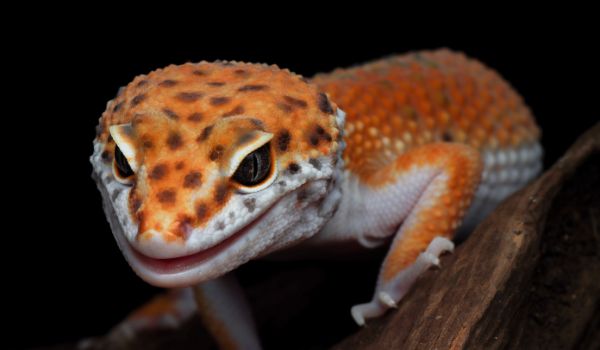
The screen lid you use should be all-metal and not plastic-framed type as it may melt when the basking light stays on for longer periods.
Cleaning Leopard Gecko Tank
Cleaning Leopard gecko tanks is not much of a hassle as their stools are dry and can be easily scooped out using a spoon. You don’t even have to worry about the Leopard gecko pee creating an odor in the tank. Because Leopard geckos’ urine is excreted along with the feces in the shape of dry white urates. Just like their dry poop, you can easily collect their urine—dry white urates. In addition to removing the defecated material from the tank, you will also have to check for dead food insects that may have eluded your gecko.
You would also have to remove and clean Leopard gecko water and food bowls now and then. This is easy, but you have to be careful about the potential Salmonella risk. You should wash the gecko bowls in your bathroom or in a sink that is not used for kitchen purposes. After having washed the gecko dishes, you should thoroughly wash the sink as well.
You can clean the glass walls of the tank inside and out with a wet paper towel, but if there are stains, you can use vinegar solution (20% vinegar in the water) instead of simple water.
If the substrate seems to have dried out, you will have to spray water on it. More so, as some substrate is removed with feces and dead insects, you will have to top off the substrate now and then.

